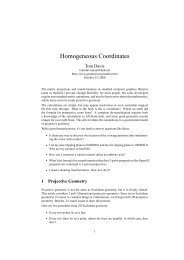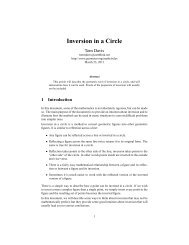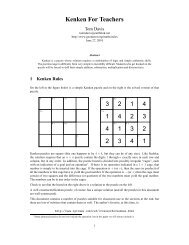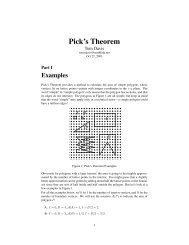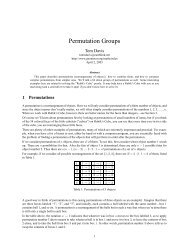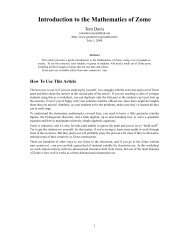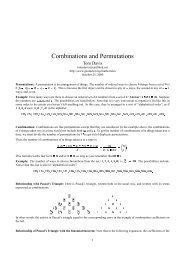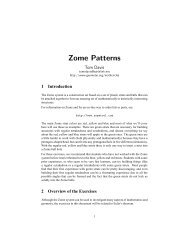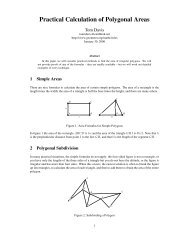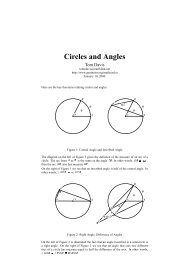P´olya's Counting Theory - Home Page -- Tom Davis
P´olya's Counting Theory - Home Page -- Tom Davis
P´olya's Counting Theory - Home Page -- Tom Davis
Create successful ePaper yourself
Turn your PDF publications into a flip-book with our unique Google optimized e-Paper software.
A group can be as simple as just the identity, where e ∗ e = e is the operation, or can be terribly<br />
complicated. They can be finite or infinite, and the study of group theory is a huge subject in<br />
mathematics.<br />
Although there are thousands of examples of groups, in this article we will only be interested<br />
in permutation groups: groups such that the elements of G are permutations of objects in some<br />
set. In such groups, if a and b are two permutations, then the permutation a ∗ b will simply be<br />
the permutation of the set’s objects by applying first permutation a and next, permutation b. The<br />
identity, e, in a permutation group is simply the permutation that leaves every object where it is.<br />
For a 5-element set {1, 2, 3, 4, 5} of objects, we would have e = (1)(2)(3)(4)(5).<br />
The inverse of a permutation a is the permutation that undoes what a does. In other words, if a<br />
moves object 1 to object 3, then a −1 moves object 3 to object 1. In the standard cycle notation,<br />
the inverse is obtained by reversing all the cycles. For example:<br />
(1)(2 3 4)(5 6)(7)(8 9) −1 = (9 8)(7)(6 5)(4 3 2)(1).<br />
5.1.1 S 3 : The Symmetric Group on 3 Objects<br />
Let’s look in detail at a particular group:the group of all permutations of the three objects {1, 2, 3}.<br />
We know that there are n! ways to rearrange n items since we can chose the final position of the<br />
first in n ways, leaving n−1 ways to chose the final position of the second, n−2 for the third, and<br />
so on. The product, n · (n − 1) · (n − 2) · · ·3 · 2 · 1 = n! is thus the total number of permutations.<br />
For three items that means there are 3! = 6 permutations:<br />
(1), (1 2), (1 3), (2 3), (1 2 3) and (1 3 2).<br />
Table 1 is a “multiplication table” for these six elements. Since, as we noted above, the multiplication<br />
is not necessarily commutative, the table is to be interpreted such that the first permutation<br />
in a product is chosen from the row on the top and the second from the column on the left. At<br />
the intersection of the row and column determined by these choices is the product of the permutations.<br />
For example, to multiply (1 2) by (1 3) choose the item in the second column and third<br />
row: (1 2 3).<br />
(1) (1 2) (1 3) (2 3) (1 2 3) (1 3 2)<br />
(1) (1) (1 2) (1 3) (2 3) (1 2 3) (1 3 2)<br />
(1 2) (1 2) (1) (1 3 2) (1 2 3) (2 3) (1 3)<br />
(1 3) (1 3) (1 2 3) (1) (1 3 2) (1 2) (2 3)<br />
(2 3) (2 3) (1 3 2) (1 2 3) (1) (1 3) (1 2)<br />
(1 2 3) (1 2 3) (1 3) (2 3) (1 2) (1 3 2) (1)<br />
(1 3 2) (1 3 2) (2 3) (1 2) (1 3) (1) (1 2 3)<br />
Table 1: Multiplication of permutations of 3 objects<br />
19





